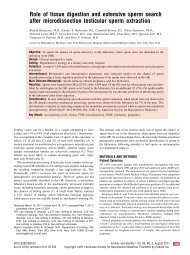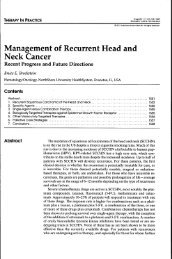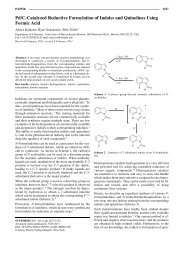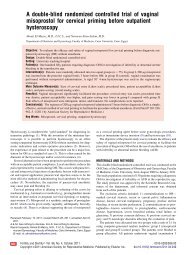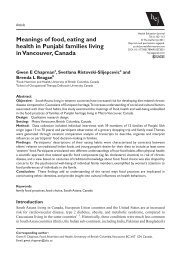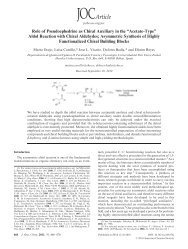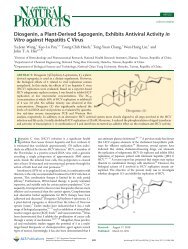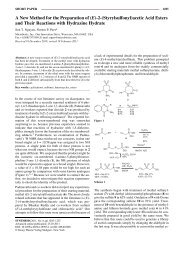Selbig and Bannerman sand-sized material. In the absence <strong>of</strong> turbulent eddies, coarse particles with high specific density become stratified and tend <strong>to</strong> be transported along the bot<strong>to</strong>m <strong>of</strong> the pipe floor. As the energy <strong>of</strong> flow in the pipe increases, sediment concentration and particle size also increase. However, the distribution <strong>of</strong> coarse particles may remain stratified. Figures 7a and 7b show the distribution <strong>of</strong> particles in water samples collected during the rising limb and peak <strong>of</strong> a s<strong>to</strong>rm hydrograph at the parking lot study area. Plots <strong>of</strong> the lower, middle, and upper sub-samples are shown with corresponding fixed-point samples <strong>to</strong> highlight changing distributions with water depth. Mean concentrations <strong>of</strong> suspended sediment for the DISA and fixed-point samplers also are shown <strong>to</strong> provide a correlation and comparison <strong>of</strong> sediment concentration and particle size with discharge (energy). At the onset <strong>of</strong> flow in the pipe, when discharge is low, particles are relatively small in diameter (d50
tions in the fixed-point samples generally stayed the same. Incorrect assumptions <strong>of</strong> PSDs in urban s<strong>to</strong>rmwater could have detrimental consequences when sizing treatment devices, such as wet detention ponds. Relationships between sediment concentration, organic content, and PSD in s<strong>to</strong>rmwater quality samples collected in the fixedpoint and DISA were consistent across a range <strong>of</strong> hydraulic conditions. These relationships were duplicated at two geograph- • ical locations with different land7use characteristics, giving confidence in the transferability <strong>of</strong> the results <strong>of</strong> this study <strong>to</strong> other urban run<strong>of</strong>f conveyance systems. Because all samples evaluated as part <strong>of</strong> this study were collected in a field setting, it was not possible <strong>to</strong> compare the results collected from each sampler with a known quantity. Additional research in a controlled labora<strong>to</strong>ry environment could provide the information necessary <strong>to</strong> verify the ability <strong>of</strong> the DISA <strong>to</strong> collect a solids concentration representative <strong>of</strong> the entire water column. Credits The authors thank Becky Carvin <strong>of</strong> the U.S.. Geological Survey (Middle<strong>to</strong>n, Wisconsin) for her tireless efforts in the field. Any use <strong>of</strong> trade, product, or firm names is for descriptive purposes only and does not imply endorsement by the U.S. Government. Submitted for publication May 3, 2010; revised manuscript submitted September 7, 2010; accepted for publication September 28, 2010. References. Agrawal, Y. C.; Pottsmith, H. C. (2000) Instruments for Particle-Size and Settling Velocity Observations in Sediment Transport. Mar. Geol., 168, 89-114. Bent, G. C.; Gray, J. R.; Smith, K. P.; Glysson; G. D. (2000) A Synopsis <strong>of</strong> Technical Issues for Moni<strong>to</strong>ring Sediment in Highway and Urban Run<strong>of</strong>f. U.S. Geological Survey Open-File Report 00-497; U.S. Geological Survey: Res<strong>to</strong>n, Virginia, 51. Cristina, C.; Tramonte, J.; Sansalone, J. (2002) A Granulometry-Based Selection Methodology for Separation <strong>of</strong> Traffic-Generated Particles in Urban Highway Snowmelt Run<strong>of</strong>f. Water Air Soil Pollut., 136, 33-53. Clark, S. E.; Siu, C. Y. S.; Pitt, R.; Roenning, C. D.; Treese, D. P. (2008) Peristaltic Pump Au<strong>to</strong>samplers for <strong>Solids</strong> Measurement in S<strong>to</strong>rmwater Run<strong>of</strong>f. Water Environ. Res., 81, 192-200. Clark, S. E.; Siu, C. S. (2008) Measuring <strong>Solids</strong> Concentration in S<strong>to</strong>rmwater Run<strong>of</strong>f: Comparison <strong>of</strong> Analytical Methods. Environ. Sci. Technol., 42, 511-516. DeGroot, G. P.; Gulliver, J. S.; Mohseni, 0. (2009) Accurate Sampling <strong>of</strong> Suspended <strong>Solids</strong>. Proceedings <strong>of</strong> the World Environmental and Water Resources Congress 2009, Kansas City, Missouri, May 17-21; American Society <strong>of</strong> Civil Engineers: Res<strong>to</strong>n, Virginia. deRidder, S..A.; Darcy, S. I.; Calvert, P. P.; Lenhart,-J. H. (2002) Influence <strong>of</strong> Analytical Method, Data Summarization Method, and Particle-Size on Total Suspended <strong>Solids</strong> Removal Efficiency. Proceedings <strong>of</strong> the Ninth International Conference on Urban Drainage, Portland, Oregon, Sept. 9-13; American Society <strong>of</strong> Civil Engineers: Res<strong>to</strong>n, Virginia. Selbig and Bannerman Edwards, T. K.; Glysson, G. D. (1999) Field Methods for Measurement <strong>of</strong> Fluvial Sediment. Techniques <strong>of</strong> Water-Resources Investigations <strong>of</strong> the U.S. Geological Survey, Book 3, Chapter C2; U.S. Geological Survey: Res<strong>to</strong>n, Virginia, 23. Fowler, G. D.; Roseen, R. M.; Ballestero, T. P.; Guo, Q.; Houle, J. (2009) .Sediment Moni<strong>to</strong>ring by Au<strong>to</strong>sampler in Comparison with Whole Volume Sampling for Parking Lot Run<strong>of</strong>f. Proceedings <strong>of</strong> the World Environmental and Water Resources Congress 2009, Kansas City, Missouri, May 17-21; American Society <strong>of</strong> Civil Engineers: Res<strong>to</strong>n, Virginia. Gray, J. R.; Glysson, G.' D.; Torcios, L. M.; Schwartz, G. (2000) Comparability <strong>of</strong> Suspended-Sediment Concentration and Total Suspended <strong>Solids</strong> Data. U.S. Geological Survey Water Resources Investigation Report 00-4191; U.S. Geological Survey: Res<strong>to</strong>n, Virginia. Horowitz, A. J. (1995) The Use <strong>of</strong> Suspended Sediment and Associated Trace Elements in Water Quality Studies, Special Publication No. 4; International Association <strong>of</strong> Hydrological Sciences: Wallingford, Oxfordshire, , United Kingdom, 58. ISCO (2008) 3700R/3740 Refrigerated <strong>Sample</strong>r Instruction Manual. http:/H www.isco.com/pcfiles/PartPDF3fUPOOOXKF.pdf (accessed December 16, 2009). Kayhanian, M.; Young, T.; Stenstrom, M. (2005) Limitation <strong>of</strong> Current <strong>Solids</strong> Measurements in S<strong>to</strong>rmwater Run<strong>of</strong>f. S<strong>to</strong>rmwater, 6 (5), 40-58. Kayhanian, M.; Rasa, E.; Vichare, A.; Leatherbarrow, J. E. (2008) Utility <strong>of</strong> Suspended Solid Measurements for S<strong>to</strong>rm-Water Run<strong>of</strong>f Treatment. J. Environ. Eng., 134, 712-721. Lenhart, J. H.; Lehman, J. M. (2006) Measuring Total Volatile Suspended <strong>Solids</strong> in S<strong>to</strong>rmwater <strong>to</strong> Understand the Influence <strong>of</strong> Organic Matter on BMP Performance. Proceedings <strong>of</strong> the World Environmental and Water Resources Congress 2006, Chicago, Illinois, Oct. 19-21; American Society <strong>of</strong> Civil Engineers: Res<strong>to</strong>n, Virginia. Pedrick, J. H.; Tellessen, G. P. (2008) Do Au<strong>to</strong>matic <strong>Sample</strong>rs Suck?: The Effect <strong>of</strong> Au<strong>to</strong>matic <strong>Sample</strong>rs on <strong>Sample</strong>s Containing Coarse Sediment. Proceedings <strong>of</strong> S<strong>to</strong>rmcon, Orlando, Florida, Aug. 3-7; Forester Media Inc.: Santa Barbara, California. Roesner, L. A.; Pruden, A.; Kidner, E. M. (2007).Improved Pro<strong>to</strong>col for Classification and Analysis <strong>of</strong> S<strong>to</strong>rmwater-Borne <strong>Solids</strong>, 04-SW-4; Water Environment Research Foundation: Alexandria, Virginia, 124. Selbig, W. R.; Bannerman, R. T. (2007) Evaluation <strong>of</strong> Street Sweeping as a S<strong>to</strong>rmwater-Quality Management Tool in Three Residential Bdsins in Madison, Wisconsin. U.S. Geological Survey Scientific Investigations Report 2007-5156; U.S. Geological Survey: Res<strong>to</strong>n, Virginia, 120. Selbig, W. R.; Bannerman, R.; Bowman, G. (2007) Improving the Accuracy <strong>of</strong> Sediment-Associated Constituent Concentrations in Whole S<strong>to</strong>rm Water <strong>Sample</strong>s by Wet Sieving. J. Environ. Qual., 36 (I), 226-232. Smith, K. P. (2002) Effectiveness <strong>of</strong> Three Best Management Practices for Highway-Run<strong>of</strong>f Quality Along the Southeast Expressway, Bos<strong>to</strong>n, Massachusetts. U.S. Geological Survey Water-Resources Investigations Report 02-4059, U.S. Geological Survey: Res<strong>to</strong>n, Virginia, 62. S<strong>to</strong>kes, G. G. (1851) On the Effect <strong>of</strong> Inertial Friction <strong>of</strong> Fluids on the Motion <strong>of</strong> Pendulums. Trans. Camb. Phil. Soc., 9, 8. April 2011 • 357



